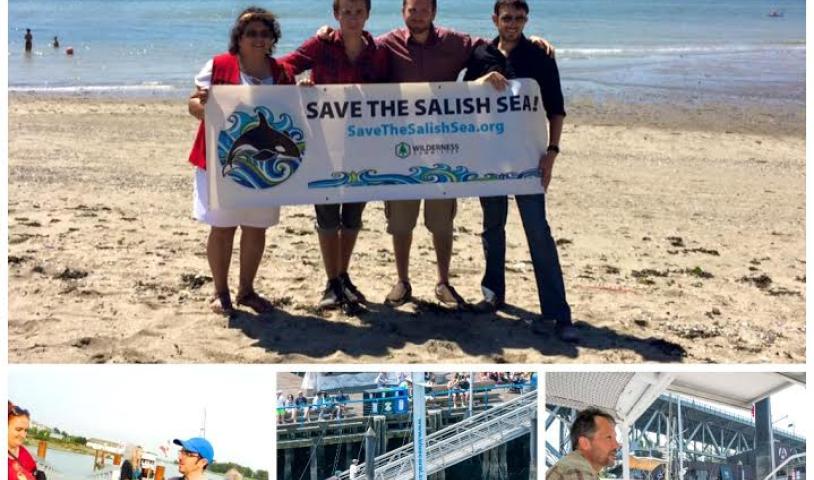Salish Sea Tour spreads alternative energy message
Tuesday, July 14, 2015
News that a 42-foot solar-powered sailing catamaran was pulling into Ganges Harbour this weekend may have failed to make waves on an island where alternative energy is already embraced, but for those in the know, it represented a significant step in the transition away from carbon-based fuels.
Sailing aboard the Aerial Sea, the 2015 Salish Sea Tour is bringing climate change activists, musicians and one crafty sailor to various ports to spread the message about the risks facing local waters due to proposed increases in oil and coal exports. It also offers a model solution that’s just now being explored.
“I have concerns about the issues here in the Salish Sea and the direction we’re heading,” catamaran owner and captain Simon Fawkes said during the Salish Sea Tour’s visit
to Salt Spring on Sunday. “But I think if we spend more energy talking about and promoting the positive alternatives, I have no doubt we can get off our addiction to fossil fuels.”
The Salish Sea Tour is a partnership of the Wilderness Committee, Tanker Free BC, Salish Sea Keepers and Vancouver-based musician Luke Wallace. They are sailing with Fawkes’ Blue Coral Charters, a Vancouver-based yacht chartering company with an environmental education focus. In ports of call like False Creek, Steveston, Pender Island and
Victoria, the participants are making connections with community groups like Transition Salt Spring as well as recreational boaters and members of the public.
Eoin Madden of the Wilderness Committee noted that advances are being made toward sustainable energy production in places like Germany and Ontario, both of which offer premium rates to people or organizations feeding alternative energy into their power grids, but Canada’s federal government is blindly focused on tar sands production.
The Salish Sea is at direct risk from the industry, with 13 separate fossil fuel export projects currently under consideration for the region. The Wilderness Committee estimates
that if all projects were to go ahead,the resulting greenhouse gas emissions would be five times greater than B.C.’s current total output.
“It’s tragic the Canadian government isn’t leading the fight to be leaders in alternative energy,” Madden said. “It’s shameful Canadians have to take it on themselves, and I’m glad they are.
“Communities on the Salish Sea are taking the initiative. There’s an amazing amount of awareness and willingness to take it on.”
Madden noted Salt Spring’s number of electric vehicles went from 10 to 50 in the space of a year, while the T’Sou-ke First Nation has become Canada’s first aboriginal solar community and is now feeding more energy into the grid than it uses.
Fawkes is one of the people pushing the boundaries of how alternative energy is applied. As it turns out, there hasn’t been much headway into the boating field so far. But according to the Blue Coral website,“a catamaran is a logical boat in
which to experiment with sustainable energy technologies because [its] low contact hull design allows for reduced friction and high energyin-energy-out ratios.”
Fawkes began exploring how to adapt his catamaran’s twinoutboard motors for solar use after discovering that replacing the troublesome gas-powered motors with electric ones wouldn’t cost much different.Then he had to discover how to incorporate solar panels and batteries.
“As an early adapter it’s taken a little more effort — I’ve had to do a lot of work to figure it out,” Fawkes said. “No one could really tell me if it would work.”
For Fawkes, part of the point of the Salish Sea Tour is to find the answers to all the questions he knows people will have, such as how far the batteries will take the boat when motoring, how fast it can go and how long it will take to charge up again depending on whether it’s sunny or cloudy.
“It’s an experiment. We’re trying to figure it all out,” he said.
Madden added the tour has been a good way to reach a new group with the alternative energy message.
“The boating community understands the worth of these waters — we’re asking them to get involved in saving the Salish Sea,” he said. And with technology becoming more accessible all the time, the message is hitting home in other ways.
“It actually makes economic sense now. People who wouldn’t necessarily identify as environmentalists are doing it because they’re saving money,” he said.
Those who missed the tour’s stop on Salt Spring can find the crew in Victoria on Saturday, July 18. The Aerial Sea will be moored at Ships Point Dock in the inner harbour from 12 to 4 p.m.
More information about the project is available on the group’s Facebook page under Salish SeaTour 2015.





